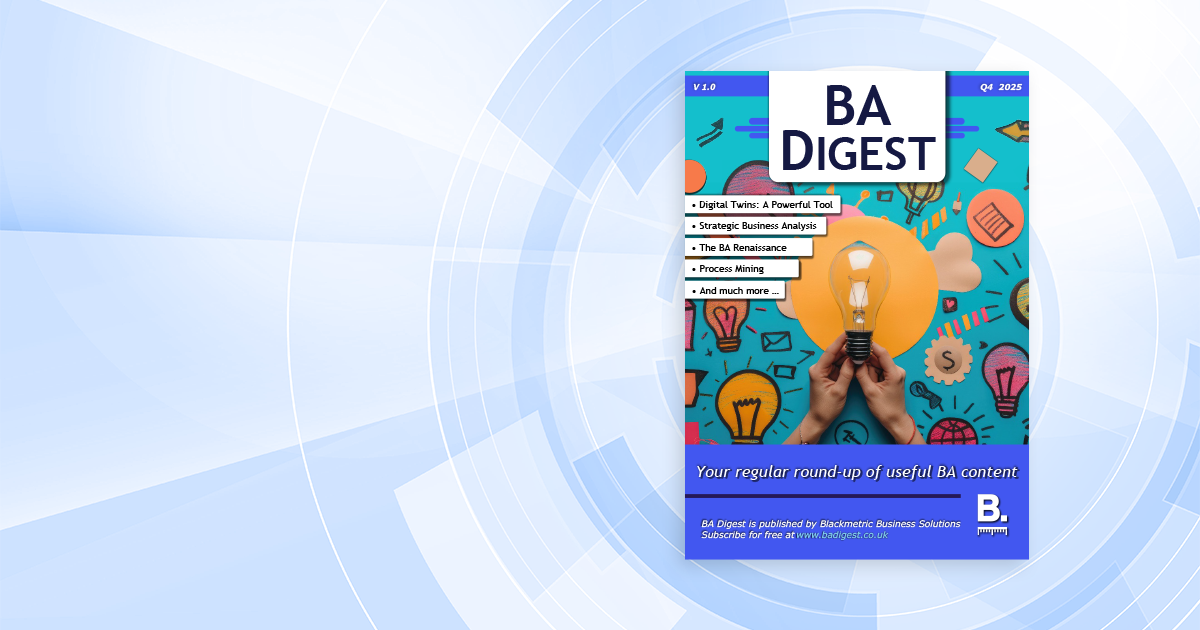From Neuroscience to Strategy
Fresh Thinking from BA Digest
Key Takeaways
Here’s what you need to know from this edition of BA Digest:
- Neuroscience and change: Understanding neuroplasticity and emotional responses helps business analysis professionals lead change with empathy and create safer, more collaborative environments
- BA Renaissance: The business analyst role is evolving from requirement gathering to strategic influence, guided by the BA RENAISSANCE Framework for ethical and user-centric innovation
- Collaboration with testers: Early collaboration between business analysis professionals and testers improves communication, trust, and product quality, leading to better outcomes
- Evolving mindset: Business analysis is shifting toward a more human-centred approach, emphasizing empathy, strategy, and collaboration
Disclaimer: The views and opinions expressed in this article are those of the author and may not reflect the perspectives of IIBA.
Business analysis never stands still. The Q4 edition of BA Digest brings practical insights from practitioners across the world. The latest issue contains seventeen articles on a diverse range of topics.
If you’re short on time, here’s a summary of three.
Neuroscience and Change
In “What on Earth Has Neuroscience Got to Do with Coping with Change?” Corrine Thomas explores how understanding the brain can help business analysis professionals handle change more effectively. She introduces the concept of neuroplasticity, the brain’s ability to form new connections and adapt through learning and repetition. This process, she explains, supports a business analysis mindset of curiosity, continuous learning, and a desire to apply new techniques.
Corrine also explores how emotions and motivation shape our reactions to change. The brain constantly balances reward and threat responses, and when situations feel uncertain, people can react defensively. Recognizing this helps business analysis professionals create an environment where stakeholders feel safe, respected, and have the tools and skills to collaborate.
A crucial takeaway from the article is that when we appreciate the fundamentals of how the brain works, we can co-design change that feels less threatening and more rewarding for everyone involved.
BA Renaissance
In “The BA Renaissance: From Scribe to Strategy Influencer,” Erivan de Sena Ramos invites us to see the business analysis profession as entering its own renaissance. Just as the historical Renaissance involved a rethinking of human potential, Erivan describes a similar shift happening within business analysis today. He observes that the business analyst role has expanded well beyond eliciting and documenting requirements to influencing strategy, shaping ethical decisions, and guiding human-centred innovation.
To help business analysis professionals embrace this shift, Erivan introduces the BA RENAISSANCE Framework, which outlines eleven principles captured in the acronym RENAISSANCE. Each principle encourages business analysis professionals to think broadly and act intentionally.
For example, Relevance through Relationships emphasizes empathy and stakeholder connection, while Architecture of Value encourages analysts to design user-centric, sustainable, and ethical outcomes. He also presents the BA RENAISSANCE Canvas, a practical one-page tool that helps business analysis professionals apply these principles and reflect on their mindset.
Business Analysts and Testers Collaborating
In “Bringing Business Analysis and Testing Together: A Journey of Integration and Collaboration,” Brenda Duffy shares a practical and people-oriented story about uniting business analysis and testing. She describes inheriting two strong but separate teams within her organization that operated in silos. Business analysts were often involved early in the process, while testers joined much later. This led to gaps in understanding and unnecessary tension.
To address this, Brenda and her colleagues introduced new ways of working that focused on earlier involvement of testers, extended business analysis engagement through later stages, and shared ownership of quality. This led to improvements in collaboration, communication, and product quality. Brenda highlights the importance of trust and respect between the disciplines, including how this leads to smoother communication, clearer acceptance criteria, and greater confidence in shared goals.
A key takeaway from the article is that when analysts and testers work side by side from the start, they achieve better outcomes together.
Connecting the Dots
There’s a key theme that underpins these three articles: business analysis is evolving not only in skills but in mindset.
Corrine reminds us that understanding the brain helps us lead change with empathy. Erivan encourages us to think strategically and ethically. Brenda shows how collaboration and trust can transform delivery. Together, these perspectives highlight a profession that is deeply human.
You can explore these articles (and much more) in the latest issue of BA Digest.
For more thought-provoking articles like the ones mentioned above, download your copy of BA Digest—a free, open-access, quarterly magazine published by Blackmetric packed with real-world business analysis insights and ideas.
About the Author

Adrian Reed is a true advocate of the analysis profession. In his day job, he acts as Principal Consultant at Blackmetric Business Solutions, where he provides business analysis consultancy and training solutions to a range of clients in varying industries. He is editor-in-chief of the quarterly open-access magazine BA Digest, and he speaks internationally on topics relating to business analysis and business change.



